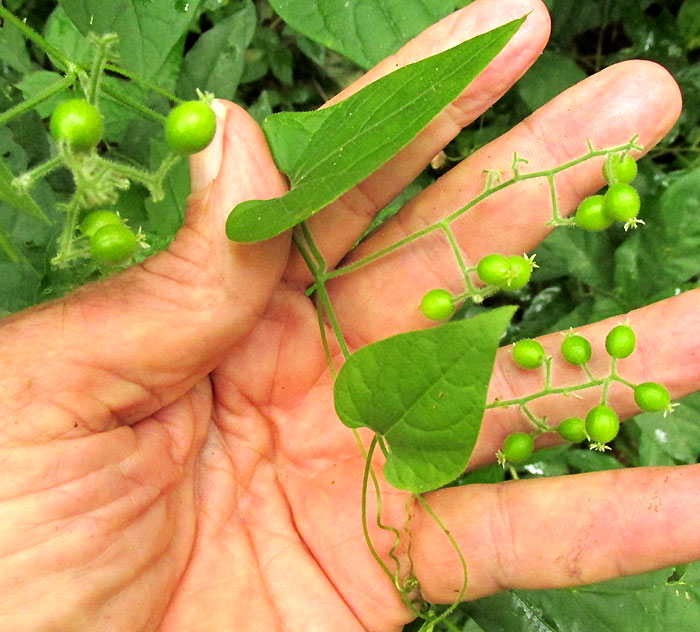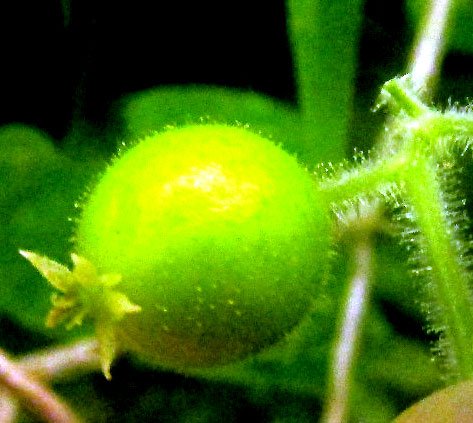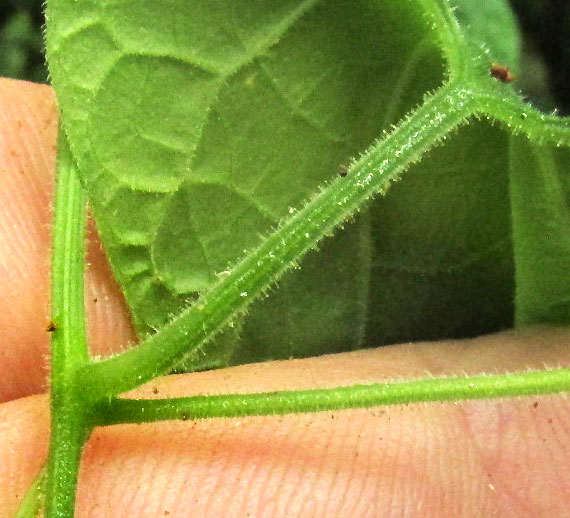Excerpts from Jim Conrad's
Naturalist Newsletter
entry from field notes dated October 9, 2022, taken about 3kms north of Gómez Farías, bushes along eroded gravel road descending toward Cañón el Azteca, Aztec Canyon, on the lower eastern slope of the Eastern Sierra Madres, El Cielo Biosphere Reserve, southern Tamaulipas state, MÉXICO; elevation about 300m (1000 ft), ± LAT. 23.04°N, LONG. 99.15°W
SICYDIUM TAMNIFOLIUM

The vine appearing above dangled from a wall of weeds, bushes and small trees along the gravel road to Cañón el Azteca. It took me awhile to even figure out which plant family it belonged to. At first glance it looked like a kind of greenbriar, genus Smilax, but that's a monocot, while this vine's net-veined leaves are definitely those of a dicot. The panicles of spherical fruits reminded me of green tomatoes in the Black Nightshade Family, but a closer look at the fruits dispelled that notion:

With the tiny calyx and corolla arising atop the developing ovary, the future fruit, the ovary is "inferior," while tomato ovaries have their calyx and corolla arising below the ovary, so they're "superior." The cluster of slender items arising from inside the calyx and corolla are three stigma-tipped styles. No stamens are present. This is a unisexual female flower, and no male flowers were evident. The above picture also shows that the dense hairs often are tipped with glands, and that's a good field mark, too.

Above it's shown how glandular hairs extend onto the inflorescence's peduncle, leaves and their petioles and the stems. In the image's lower, left corner, a tendril can be seen arising on the stem node, not in the petiole's axil as in some plant families with vines, but to the side, and that's another notable feature.
On the Internet there's a wonderful, interactive, Key to Neotropical Plant Families for identifying the families of tropical American plants. At this writing, the key starts out with 319 possible tropical American plant families. Simply by plugging in the information that our plant is a vine with tendrils drastically narrows down the number to 34. The flowers producing inferior ovaries further reduces the possibilities to 6 families. The fruits being fleshy brings it down to 4. The flowers being arrayed in panicles reduces it to 2 possible families, of which one is the huge, very diverse Composite or Daisy Family, which this plant obviously isn't a member of, and the other is the Gourd/Squash/Cucumber Family, the Cucurbitaceae.
Of course! We've seen members of the Gourd Family bearing numerous bean-sized, fleshy fruits held in complex inflorescences before, for example Cayaponia racemosa in the Yucatán.
The Gourd Family is a big, complex one, maybe with around 960 species in some 95 different genera. There's no good treatment of the family in Mexico, but a 1993 study of the family in the Flora de Veracruz gives a good overview of the species in Veracruz, the state adjoining Tamaulipas in the south. However, that work's keys rely heavily of features of male flowers so for me it was practically useless. Still, among the three volumes' there are drawings of representative species in various genera, and fortunately our species was featured, easy to distinguish with its unlobed, heartshaped leaves and small, spherical fruits arrayed in panicles. It's SICYDIUM TAMNIFOLIUM.
Sicydium tamnifolium, with no commonly accepted English name, is distributed from about this latitude in northeastern Mexico and the Caribbean south through Central America into northwestern South America and along the coast in southeastern Brazil. The species is described as inhabiting various disturbed tropical forest types at elevations up to 450m (1500ft). Probably the plants flower all the year.
The online Atlas de las Plantas de la Medicina Tradicional Mexicana tells us that in the Yucatán the roots of Sicydium tamnifolium are used traditionally to treat skin infections. A variety of ways of preparing the roots is practiced, including simply mashing and spreading them over the infected area for 24 hours, or macerating them and soaking them in anise liquor, making an extract that can be applied. Numerous ingredients can be added to the medication to increase potency, including passion-flower vine leaves, parrot feathers and a child's urine. Also the cure is helped along if a red ribbon is tied above the infection. Sometimes the root combined with other items is used to cure tumors.
With its unusually small, spherical fruits arrayed in panicles so unlike most squash, cucumber and gourd species, I was curious about its evolutionary history -- its phylogeny. The 2009 publication by Hanno Schaefer and others entitled "Gourds afloat: a dated phylogeny reveals an Asian origin of the gourd family (Cucurbitaceae) and numerous oversea dispersal events," based on genetic sequencing, reported not only that the Gourd Family arose in Asia, but also this: At the end of the Cretaceous Period about 66 million years ago, "... ,Cucurbitaceae underwent at least 43 successful LDD {long-distance dispersal} events over the past 60 Myr, which would translate into an average of seven LDDs every 10 Myr." Today the Gourd Family is native to Asia, the Americas and Africa.
Sicydium tamnifolium belongs to the subfamily Fevilleeae, whose first ancestor is judged to have arisen within the Gourd Family about 46 million years ago. The Sicydium genus emerged from its South American relatives about 40 million years ago. This dateline is informed by modern species of the Gourd Family bearing fruits adapted for transport by water, birds or wind. With their small size and fleshy coverings, Sicydium species like ours appear to be bird dispersed.
These dates and facts conjure a hint of an image of the ancestors of American species of the Gourd Family somehow arriving here from Asia, probably via ocean currents, possibly first landing in South America, then descendants migrating north. Maybe some of the ancestors arrived by different routes. Somewhere during the course of our plant's evolution, the Goard Family's floating-fruit strategy was replaced by the bird-dispersal one, and eventually our Sicydium tamnifolium ended up along a much-eroded gravel road well inland and 300m high in northeastern Mexico.